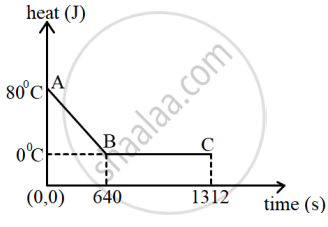Advertisements
Advertisements
प्रश्न
Explain how heat capacity of a solid can be determined by the method of mixture.
उत्तर
- The solid object whose specific heat is to be determined is heated and then put in water in a calorimeter.
- Solid object loses heat energy to water and calorimeter till temperature of all three become equal.
- According to principle of heat exchange,
Heat lost by a solid object (Q) = Heat gained by calorimeter (Q1) + Heat gained by water in the calorimeter (Q2)
This means,
mass of the solid object × its specific heat × in its temperature
= (mass of the calorimeter × its specific heat × increase in its temperature) + (mass of the water × its specific heat × increase in its temperature). - Using this equation, if the specific heat of water and calorimeter are known and other physical quantities are measured accurately, the specific heat of solid object can be determined.
APPEARS IN
संबंधित प्रश्न
What property of water makes it an effective coolant?
Heat energy is supplied at a constant rate to 100g of ice at 0 °C. The ice is converted into water at 0° C in 2 minutes. How much time will be required to raise the temperature of water from 0 °C to 20 °C? [Given: sp. heat capacity of water = 4.2 J g-1 °C-1, sp. latent heat of ice = 336 J g-1].
A solid metal weighing 150 g melts at its melting point of 800 °C by providing heat at the rate of 100 W. The time taken for it to completely melt at the same temperature is 4 min. What is the specific latent heat of fusion of the metal?
Why do the farmers fill their fields with water on a cold winter night?
Discuss the role of high specific heat capacity of water with reference to climate in coastal areas.
Water property of water makes it an effective coolant?
A mass m1 of a substance of specific heat capacity c1 at temperature t1 is mixed with a mass m2 of other substance of specific heat capacity c2 at a lower temperature t2. Deduce the expression for the temperature t of the mixture. State the assumption made, if any.
State the effect of enhancement of green house effect.
What impact will global warming have on the health of the affected population?
What is meant by specific heat capacity?
Study the following procedure and answer the questions below:
1. Take 3 spheres of iron, copper and lead of equal mass.
2. Put all the 3 spheres in boiling water in a beaker for some time.
3. Take 3 spheres out of the water. Put them immediately on a thick slab of wax.
4. Note, the depth that each sphere goes into the wax.
i) Which property of substance can be studied with this procedure?
ii) Describe that property in minimum words.
iii) Explain the rule of heat exchange with this property.
Give one example where high specific heat capacity of water is used as cooling.
Does the specific heat capacity of a substance depend upon its mass and rise in temperature only?
Derive Mayer’s relation.
_______ is defined as the amount of heat required to raise the temperature of 1kg of a substance by 1°C.
Which of the substances P, Q, or R has the lowest specific heat? The temperature v/s time graph is shown ______.

On supplying 100 µC of charge to a conductor, its potential rises by 5 V then capacity of the conductor is ______.
The diagram below shows a cooling curve for 200 g of water. The heat is extracted at the rate of 100 Js-1. Answer the questions that follow:

- Calculate specific heat capacity of water.
- Heat released in the region BC.
Calculate the amount of heat energy required to raise the temperature of 200 g of copper from 20°C to 70°C. Specific heat capacity of copper = 390 J kg-1 K-1.
